Landscaping can transform your home's appearance and improve its resale value. When landscaping, the material you use as mulch makes a difference in how it looks and what benefits it adds to your landscaping.
Landscapers have several options when choosing their landscaping materials; each type has different pros and cons depending on how you plan to use it.
If you are keen to find out more, then keep on reading!
Landscaping Mulch
Paid landscaping services can be expensive if you use landscapers for frequent repairs, maintenance, or for landscaping large areas. But the benefit is that landscapers will usually provide landscaping mulch to help control weeds without additional landscaping material costs.
They may also know which landscaping materials best suit your landscaped areas based on unique conditions. Conditions like sun exposure, vegetation or moisture levels might not matter much in other situations.
Landscapers tend to use more landscaping mulch than many homeowners would consider doing since they want to ensure plants receive adequate moisture and protection from weed growth. However, this means extra landscaping material costs and landscape material storage needs.
For landscaping projects of more minor landscaped areas with shorter landscaping periods, landscapers use landscaping materials like landscaping mulch. It is more economical and easier to work with than landscaping fabric options for large areas or long periods.
Landscapers use decorative stones as landscaping mulch because they're easily shaped into beautifully landscaped beds. This mulch provides reasonable weed control compared to other landscaping material options. The stone's weight keeps them in place, so they don't blow away in high winds or wash away during heavy rains.
Peat Moss
Peat moss is a good landscaping mulch for this purpose, as it not only keeps the weeds down and makes your landscaping beautiful but adds nutrients to your soil that can improve plant growth. It also stays where you put it and isn't prone to wind and water damage like other landscaping material choices.
Peat moss is lightweight; however, adding too much can make the landscaping look overgrown and reduce airflow around plants, leading to disease or moisture issues.
Peat moss doesn't break down quickly as bark mulch does, so it's often used as living mulch instead of landscaping mulch. Living mulches prevent weeds from growing between landscaping beds without using landscaping fabric or landscaping stones, so it's more environmentally friendly.
Living mulch made of peat moss also reduces the need for mowing and watering by slowing evaporation at ground level, reducing landscaping water usage.
Peat moss as landscaping mulch is one of the most popular landscaping materials because it looks natural, benefits soil quality, reduces maintenance requirements, and expands landscaped bed spaces. They will provide cushioning for heavy soils and protect landscaped areas against weeds.
Peat moss is usually available in compressed bales four feet wide by six feet long by four inches thick; however, it may also be loose like regular mulch. One cubic yard covers 28 square feet with a four-inch depth.
Bark Landscaping Mulch
Bark landscaping mulch is one of the most popular landscaping materials because it looks natural, reduces maintenance requirements, expands landscaped bed space and protects landscaped areas against weeds.
This mulch also adds nutrients to soil quality that aids plant growth, but it doesn't stay in a place like other landscaping material choices. It can be blown around by wind or carried away by water runoff.
Landscapers may use bark mulch as organic landscaping mulch instead of inorganic or synthetic mulch; however, using too much can make the landscaping look overgrown and reduce airflow around plants. This could lead to disease or moisture issues since some will decompose and leave holes in landscaping beds.
Bark landscaping mulch decomposes quickly and is not as environmentally friendly as other landscaping materials. Over time, it can affect drainage and soil quality, so it should only be used as landscaping mulch for single projects or short landscaping periods.
Bark landscaping mulch is usually available in compressed bales four feet wide by six feet long by four inches thick; however, it may also be loose like regular mulch. One cubic yard covers 28 square feet with a four-inch depth.
Like peat moss, bark landscaping mulch adds nutrients to the soil, reduces maintenance requirements, expands bed space, and protects landscaped areas against weeds.
As landscaping mulch, bark mulch is an attractive, easy to work with landscaping material option; however, it may not hold up for extended periods as landscaping fabric does.
Wood Chips Landscaping Mulch
Wood chips landscaping mulch is another popular material used because it's inexpensive and adds nutrients to the soil to improve plant growth. It also looks natural and reduces the need for mowing and watering by slowing evaporation at ground level, reducing landscaping water usage.
However, wood chips aren't as attractive or sturdy as other landscaping materials since they tend to blow away in high winds or wash away during heavy rains. Wood chips mulch is usually available loose like regular landscaping mulch. A cubic yard covers 28 square feet with a four-inch depth.
Woven Landscaping Fabric
Woven landscaping fabric provides weed control and erosion protection as landscaping mulch. Still, it can be pricey for large landscaped areas - plus, the coating may crack over time, leading to moisture issues if not replaced.
Some woven landscaping fabrics are designed to allow water through to plants; however, lightweight materials that rely on soil contact alone tend to let more moisture seep through than heavier options that provide some protective qualities.
Landscapers use woven landscaping fabric for landscaping projects of more extended landscaping periods. It's usually sold in 10-by-100-foot rolls three feet wide, but landscapers can cut the fabric to fit their landscaped areas.
Pruned Landscaping Branches
Pruned landscaping branches look attractive as landscaping mulch and provide insulation for plants by reducing soil temperature extremes. They also reduce water evaporation at ground level, which can help reduce landscaping irrigation needs.
However, landscaped beds filled with pruned landscaping branches will still let some water through if they're not watered correctly. Landscapers may need to use more landscaping mulch for this reason.
Landscapers use pruned landscaping branches as living mulch because the plant material decomposes and becomes part of landscaping bed soil.
Natural Stone
For this reason, many homeowners choose to use natural stones instead of decorative stones for their landscape projects. This mulch is easier to move around and doesn't retain too much heat in hotter months. Natural stone options like boulders are trendy for large garden areas where you want a bold appearance or need something heavy. Meaning it won't become dislodged by dogs or kids running through the space.
However, these natural stones can be prohibitively expensive if you work with small project budgets. They may not provide reasonable weed control compared to other landscape material options.
Weed Cloth
Weed cloth is an economical landscape material option if you work with large projects or cover multiple areas. However, it doesn't provide much weed control. So many landscapers use heavy landscape materials like decorative stone over weed cloth for weed control purposes. It can add up in terms of cost since you'll need both types of landscaping material.
Weed cloth's strength is also one of its main weaknesses - landscapers can't shape weed cloth landscaping beds as quickly as landscaping fabric options because the landscaped areas are less flexible to work with.
However, landscapers prefer weed cloth landscape materials for windy areas where you don't want landscaped beds to shift in the wind and expose the ground underneath or for steep slopes which could collapse under a heavy weight.
These materials provide good protection from weeds growing through them. However, laying landscaping fabric or weed cloth down underneath landscaping mulch is still important. Mainly you'll be planting seeds or digging into your landscaped beds since even organic soils can contain weeds germinating later on as the landscaped areas break down.
Landscaping Fabric
Landscapers also prefer landscaping fabric for windy areas. If you live in an area prone to high winds, landscapers will probably use landscaping fabric over weed cloth. However, landscaping fabric is more expensive than weed cloth. This means additional landscaping material costs - plus, it can be hard to use when dry, although landscapers usually only use it in wet conditions when needed.
In summary, the choice for landscaping mulch depends on the suitability for every project type due to concerns about cost-effectiveness or reliability.
For additional information, be sure to contact Landscaping St Catharines. We are landscaping professionals who can help you create beautifully landscaped areas at an affordable cost.
Contact us today!



